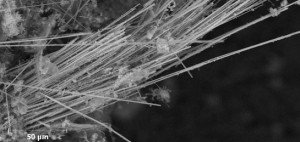Madison County, Illinois, has long been a favored jurisdiction for plaintiffs to file asbestos cases, regardless of where they reside or where their exposure occurred. This trend has accelerated over the past three years, with thousands of asbestos filings there each year.
Recently, new firms have begun filing there, encouraged by the prospects of favorable juries and favorable damages law. For example, Madison County set a record last year with 1,678 new asbestos case filings, more than any other jurisdiction in the nation, a 42 percent increase in filings since 2010. In the first quarter of 2014, out-of-state plaintiffs’ firms filed a majority of the new cases, a shift from 2010 when local firms held the majority. Recently, when Judge Stephen A. Stobbs denied four forum non conveniens motions to dismiss, Madison County sent the message – loud and clear – that it is open for business and welcomes new filings from out of state.
Defendants in four different cases moved for dismissal based on forum non conveniens by arguing that Madison County was an inconvenient venue for the parties. Beacher (Brown) v. American Biltrite Co. (Case No. 12-L-1392); Warden v. Caterpillar, Inc. (Case No. 12-L-1065); Murphy v. CBS Corp. (Case No. 12-L-1141); and Hunt (Munsey-Hunt) v. 84 Lumber Co. (Case No. 12-L-1140). Under Illinois Supreme Court Rule 187(c)(2), a court that has jurisdiction over the parties and the subject matter involved “may nevertheless decline jurisdiction of a case when it is apparent that trial in another forum with jurisdiction over the parties would be more convenient and better serve the ends of justice.” Berbig v. Sears Roebuck & Co. Inc., et al., 378 Ill. App. 3d 185, 188 (1st Dist. 2007) quoting Vinson v. Allstate, 144 Ill. 2d 306, 311 (1991); see Il. S. Ct. R. 187.
Each of the four motions was predicated on similar facts: (1) none of the plaintiffs lived in Illinois, let alone Madison County, and (2) none of the plaintiffs ever worked in Illinois, let alone Madison County. While venue was proper based on the presence of a Madison County defendant, the defendants argued that Madison County was inconvenient for all the parties and the witnesses involved, and the cases should be dismissed.
Despite the obvious lack of connection to Illinois, Stobbs denied all four motions. Stobbs insisted that for defendants to meet their burdens under the motion, they must demonstrate which court would be the appropriate court to try the cases, whether such court would have jurisdiction and venue over all parties to the case, and whether this court would be more convenient to all parties to the litigation. Stobbs found that the defendants’ motions failed to adequately address which forum would be more convenient and how that forum would be more convenient to each and every party. The defendants argued that the standard is almost impossible to show when a plaintiff sues dozens or hundreds of defendants at a time (standard in asbestos cases), and essentially makes the forum non conveniens doctrine a dead letter in Madison County asbestos cases.
These rulings herald that Madison County is “open for business” to asbestos plaintiffs, regardless of where the operative events took place. This is all the more concerning given that numerous out-of-state firms have recently filed in Madison County for the first time, and its asbestos docket has substantially increased over the past three years. As the West Coast becomes less attractive to plaintiffs because of legal developments in those jurisdictions, these decisions clearly solidify Madison County’s reputation as a venue of choice for plaintiffs nationwide.
Three of the four decisions are being appealed. In their appeals, the defendants argue that Stobbs abused his discretion in denying the forum non conveniens motions in cases that have absolutely no connection to Illinois. The defendants maintain that these cases should be tried in the most appropriate forum, the one with the most connections to the case.
The defendants also cite staggering statistics to support their argument that sustaining Stobbs’ denials would render the forum non conveniens doctrine virtually useless in Madison County. The defendants use the firm of Napoli, Bern, Ripka, Shkolnik, which represents these plaintiffs, as an example. The firm’s filings rose from 343 in 2012 to 548 in 2013, making it the top asbestos filer in the county. Napoli also files a majority of the lung cancer cases in Madison County, which is particularly concerning because lung cancer is most often caused by smoking and non-asbestos-related causes. The defendants argue that if Madison County opens its arms to lung cancer cases from around the country, most of which will have no ties to Illinois, then those filings will “overwhelm the docket, swamp the court and crowd out court resources that would otherwise be available to actual Madison County residents.”
As the Illinois Court of Appeals decides whether to overturn Stobbs’ decisions, Madison County will remain “open for business” for plaintiffs all around the country. Regardless of whether those plaintiffs have stepped foot inside the state, worked for an Illinois company, or come close to a product manufactured by an Illinois business, for now, they are welcomed with open arms in Madison County.
 No longer will employers be entitled to rely on the Illinois workers’ compensation exclusive remedy protections to prohibit civil actions filed 25 years or more after a worker’s alleged exposure. On May 17, 2019, Illinois Governor J.B. Pritzker signed into law Senate Bill 1596, which allows tort claims to be filed after the state’s occupational-disease 25-year time bar expires. Effective immediately, the Illinois Workers’ Compensation Act and Illinois Occupational Disease Act no longer prohibit workers diagnosed with latent diseases from pursuing their claims with their workers comp attorney after the 25-year statute of repose.
No longer will employers be entitled to rely on the Illinois workers’ compensation exclusive remedy protections to prohibit civil actions filed 25 years or more after a worker’s alleged exposure. On May 17, 2019, Illinois Governor J.B. Pritzker signed into law Senate Bill 1596, which allows tort claims to be filed after the state’s occupational-disease 25-year time bar expires. Effective immediately, the Illinois Workers’ Compensation Act and Illinois Occupational Disease Act no longer prohibit workers diagnosed with latent diseases from pursuing their claims with their workers comp attorney after the 25-year statute of repose.
 The overruled decision, AlliedSignal v. Ott, 785 N.E.2d 1068 (Ind. 2003), had upheld the asbestos statute of repose against an Equal Privileges and Immunities Clause challenge. Ott held that while there was a distinction “between asbestos victims and other victims under the product liability act,” the statute of repose did not harm asbestos plaintiffs because they are either subject to the same statute of repose as non-asbestos plaintiffs or have an exception if the defendant “mined and sold commercial asbestos.”
The overruled decision, AlliedSignal v. Ott, 785 N.E.2d 1068 (Ind. 2003), had upheld the asbestos statute of repose against an Equal Privileges and Immunities Clause challenge. Ott held that while there was a distinction “between asbestos victims and other victims under the product liability act,” the statute of repose did not harm asbestos plaintiffs because they are either subject to the same statute of repose as non-asbestos plaintiffs or have an exception if the defendant “mined and sold commercial asbestos.” the District Court of Utah rejected plaintiff’s attempt to use “single fiber” expert testimony.
the District Court of Utah rejected plaintiff’s attempt to use “single fiber” expert testimony.